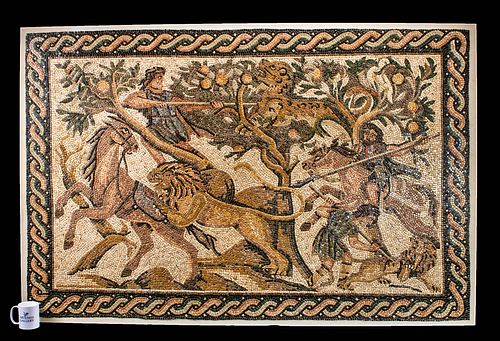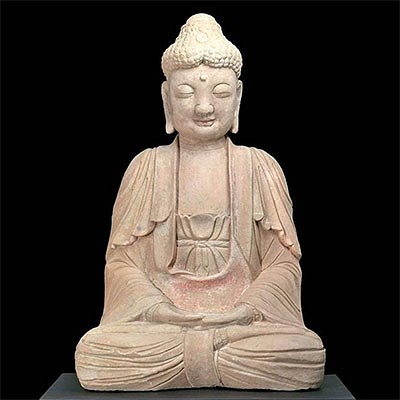Stunning & Huge Roman Stone Mosaic w/ Hunting Scene
Lot 38a
About Seller
Artemis Fine Arts
686 S Taylor Ave, Ste 106
Louisville, CO 80027
United States
Selling antiquities, ancient and ethnographic art online since 1993, Artemis Gallery specializes in Classical Antiquities (Egyptian, Greek, Roman, Near Eastern), Asian, Pre-Columbian, African / Tribal / Oceanographic art. Our extensive inventory includes pottery, stone, metal, wood, glass and textil...Read more
Categories
Estimate:
$40,000 - $60,000
Absentee vs Live bid
Two ways to bid:
- Leave a max absentee bid and the platform will bid on your behalf up to your maximum bid during the live auction.
- Bid live during the auction and your bids will be submitted real-time to the auctioneer.
Bid Increments
| Price | Bid Increment |
|---|---|
| $0 | $25 |
| $300 | $50 |
| $1,000 | $100 |
| $2,000 | $250 |
| $5,000 | $500 |
| $10,000 | $1,000 |
| $20,000 | $2,500 |
| $50,000 | $5,000 |
| $100,000 | $10,000 |
| $200,000 | $20,000 |
About Auction
By Artemis Fine Arts
Feb 18, 2021
Set Reminder
2021-02-18 10:00:00
2021-02-18 10:00:00
America/New_York
Bidsquare
Bidsquare : Exceptional Antiquities, Asian, Ethnographic
https://www.bidsquare.com/auctions/artemis-gallery/exceptional-antiquities-asian-ethnographic-6373
Museum-worthy examples of Egyptian, Greek, Roman, Etruscan, Near Eastern, Far East / Asian, Pre-Columbian, African / Tribal, Oceanic, Native American, Spanish Colonial, Russian, Fossils, Ancient Jewelry, Fine Art, so much more! Artemis Fine Arts info@artemisfinearts.com
Museum-worthy examples of Egyptian, Greek, Roman, Etruscan, Near Eastern, Far East / Asian, Pre-Columbian, African / Tribal, Oceanic, Native American, Spanish Colonial, Russian, Fossils, Ancient Jewelry, Fine Art, so much more! Artemis Fine Arts info@artemisfinearts.com
- Lot Description
Roman, Imperial Period, ca. 1st to 3rd century CE. An outstanding stone mosaic depicting a dramatic hunting scene featuring three hunters, one still on horseback (right of composition) aiming his spear at the wild lion that is about to attack his companion's horse at the left of the composition; a second man in the act of slaying another lion at the lower right of the composition; finally a third hunter, depicted in composite profile as he pierces a tiger that evidently climbed a fruitful tree at the center of the composition with his intimidating sword. All is painstakingly delineated from thousands of square/rectangular tesserae of russet, sienna, chocolate brown, taupe, golden ochre, tan, gray, peach, black, olive green, royal blue, vermilion red, and white hues against a creamy beige ground. The hunters as well as the animals are rendered with a captivating sense of motion - their body weights shifted this way and that, as their limbs are raised or curled to demonstrate their potential energy by virtue of these dynamic positions. Size (mosaic): 71.9" W x 46.75" H (182.6 cm x 118.7 cm); (frame backing): 74" W x 48.6" H (188 cm x 123.4 cm)
Note the heightened expressions on each visage and how even the border's tesserae are arranged in sinuous, intertwining bands, thus amplifying the dynamism of the hunt! A magnificent mosaic that was clearly made by a master artisan, probably to grace an elite family's villa.
Mosaics (opus tesellatum) are some of our enduring images from the Roman world, not only for their aesthetic beauty, but also because they reveal what Romans chose to depict and see every day decorating their private and public spaces. This piece at first glance seems quite simple - men hunting wild felines - two lions and a tiger - in the wild. However, the symbolism of the iconography is layered and rich. In the classical world, lions symbolized power, wealth, and might. They were famously featured in many ancient myths, perhaps the most famous being that of Hercules (Greek Herakles) slaying the Nemean lion for his first labor. The lions' fur was believed to be impenetrable to attacks, since according to legend it was made of gold and its claws were far sharper than swords with the power to slice through armor. In the end, Hercules defeated the lion by strangling it and wore its skin. Lions were also favorite iconography for buildings, coins, and statues. Examples include the Lion Gate to the Citadel of Mycenae, the Terrace of the Lions on the island of Delos, and the lion hunt mosaic from Pella featuring Alexander engaged in a lion hunt. Of course lions were also the stars of Roman arenas where they would fight other animals, such as tigers and bears.
Horses were also a frequent subject of ancient mosaics, especially ones from Roman North Africa, where the horses of Algeria (known as Numidia) were renowned, and citizens were passionate about chariot races and hunting. One mosaic found there, for example, portrays a race horse with the words, "Win or lose, we love you, Polidoxus." This mosaic, however, portrays a hunting scene akin to the one in the Bardo Museum, Tunisia, that depicts a hunting party where the horse Leonidas is throwing his rider alongside several other horses and riders wearing bridles and reins.
Provenance: ex-Phoenicia Holyland Antiquities, New York, New York, USA, purchased in the late 1980s; ex-Mr. David Leibert collection, New York, New York, USA
All items legal to buy/sell under U.S. Statute covering cultural patrimony Code 2600, CHAPTER 14, and are guaranteed to be as described or your money back.
A Certificate of Authenticity will accompany all winning bids.
We ship worldwide and handle all shipping in-house for your convenience.
#161983Mounted on a concrete backing and framed. Losses to a few tesserae commensurate with age, with chips and abrasions to other tesserae in scattered areas, light encrustations, and light fading to colors of some tesserae. Gorgeous preservation to decorative motifs and wonderful remains of tesserae coloration.Condition
- Shipping Info
-
All shipping is handled in-house for your convenience. Your invoice from Artemis Gallery will include shipping calculation instructions. If in doubt, please inquire BEFORE bidding for estimated shipping costs for individual items.
-
- Buyer's Premium



 EUR
EUR CAD
CAD AUD
AUD GBP
GBP MXN
MXN HKD
HKD CNY
CNY MYR
MYR SEK
SEK SGD
SGD CHF
CHF THB
THB




















